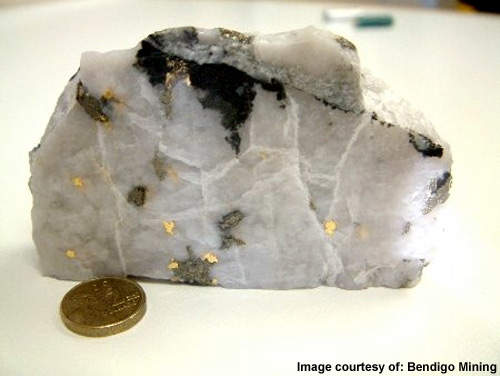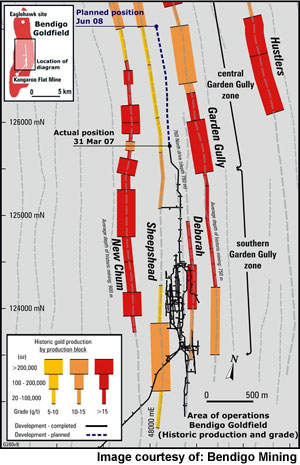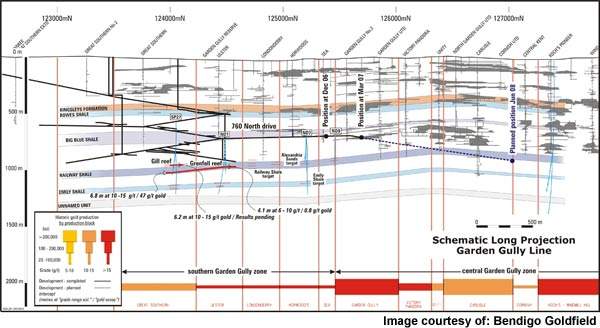The newly commissioned Kangaroo Flat Gold Mine is located at the southern end of Victoria’s Bendigo goldfield – the world’s largest ‘slate belt’ field. Bendigo was a key centre during the State’s gold rush of the 1850s and yielded the second highest historical production in Australia, surpassed only by Kalgoorlie’s ‘Golden Mile’.
Production from the field stopped in 1954, so when Bendigo Mining poured the first gold bar from its new mine in July 2006, it seemed that the talk of a renaissance was about to become reality. Formally opening the mine in the October, Victorian Premier Steve Bracks described it as the start of ‘a great second gold rush for central Victoria’.
However, after it became apparent that the mine’s potential had been overestimated – a revelation which was to slash the company’s share price. Ore production ceased in May 2007 and the next month, the 600,000t/y processing plant was placed on care and maintenance.
Fortunately, the wisdom of calling a halt to allow time for re-assessment and new strategic planning was to become clear with July’s report of the discovery of new unmined targets, with a large tonnage potential, and a rally in the company’s fortunes.
GEOLOGY
The Bendigo goldfield is located in the Bendigo-Ballarat zone of the Palaeozoic Lachlan Fold Belt of eastern Australia, which has an orogenic past that spans from Cambrian to Carboniferous periods. The geology exhibits evidence of the region’s turbulent history of tectonic movement, folding, faulting and volcanism, containing rocks of igneous, metamorphic and sedimentary character.
The goldfield itself lies within a 9km-wide block of Lower Ordovician turbidites – the productive portion being a region some 15km x 5km in extent, towards the centre of this block. The bedrock of the area is a regular sequence principally comprising turbiditic sandstones, siltstones and mudstones, with well-preserved sedimentary structures which display little deformation.
There are several faults in the area. The goldfield’s block of Lower Ordovician turbidites is bounded by the Whitelaw and Sebastian Faults, steep reverse faults with a displacement of at least 1,500m. Other minor forms are also encountered – bedding-plane, break and oblique faults – which have been established as potential host of quartz-gold mineralisation.
In the Bendigo Field, all known gold mineralisation – which runs through at least 3.2km of strata – is associated with quartz veining, occurring either as free gold within quartz or in association with sulphides in or adjacent to quartz veins. The reefs themselves are formed from either laminated or bucky quartz and may contain dolomitic carbonate, albite and pyrites. Most of the deposit is coarse gold – visible nuggets with a diameter of 1mm or more – erratically distributed within the reefs.
RESERVE AND GRADE ESTIMATION
There are four main lines of mineralisation in the field: Sheepshead, Deborah, Garden Gully and New Chum. The company’s probable ore reserve had been put at 656,000t at a grade of nine grams of gold per tonne, with Bendigo forecasting a production of 200,000oz in 2009/10, trebling to 600,000oz per year, within two years.
However, after reconciling the December quarter 2006 production results, it became clear that the potential of the Sheepshead and Deborah Lines had been overestimated and this reserve figure has been cut by a third, while the grade has been lowered to 7–9g of gold per tonne of ore.
The original inferred resource estimate had been made by extrapolating a geological ribbon repeat model, derived from the historical production from the upper mined zones, into the deeper un-mined zones below. Where gold presents itself in nuggets, however, producing an accurate representation of the reef’s grade requires an extensive sampling regime, since a single drill intersection can miss individual pieces.
Accordingly, grade determination at Bendigo has been a challenge and the company has switched to a more fundamental approach – relying on a visual examination of the core – and no longer report statistically-factored gold grades.
Estimations of inferred resources are now to be made based on data from drilling on appropriate sections spaced 120m apart and will involve ranking the key geological inclusions and features visible in the drill core. This, in combination with assays, should provide a method of assessing the likely gold grade which is better suited to the local conditions.
THE FUTURE
Despite the discovery of lower than expected initial reserves, the results of the trial mining on the Sheepshead and Deborah lines did give some encouragement, with gold grades averaging 5.5g/t over the six-month period. This has been seen as a positive indication, taken against the dilution effect of mining mineralised formations which proved narrower than had first been anticipated. In addition, the 8.6g/t returned in March 2007 approximated very closely to the original 9g/t estimated probable reserve.
With work on the Sheepshead and Deborah lines now stopped, exploration efforts are focused on the more prospective areas of the Garden Gully and New Chum lines.
Historically, these lines accounted for a little over 70% of production: Garden Gully mines yielding more than 85t of gold between the mid-19th and the early part of the 20th Centuries, with the New Chum line producing almost 65t over the same period.
Two new large reefs have been discovered on Garden Gully – Grenfell East and Grainger – comprising multiple quartz veins and solid quartz bodies. Although the sections tested to date would suggest they are likely to be low grade, they are believed to have significant large tonnage potential.
The company’s revised strategy will see these resources being targeted down to around 1,200m, the drilling being conducted from underground locations within the existing mine. This programme aims to identify, explore and build reserves in the more productive zones, with the objective of achieving reliable production of 150,000–200,000oz a year from the Kangaroo Flat Mine.







